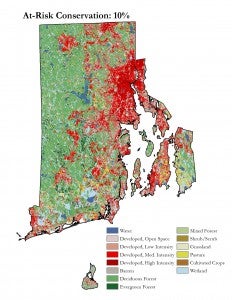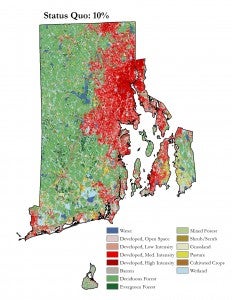Key Results
 Our results indicate urbanization has a largely negative impact on overall levels of ecosystem service delivery. However, the relationship between urbanization and ecosystem service delivery varies across ecosystem services. First, we find that the level of nutrient loading into the state’s watersheds can be significantly higher than the corresponding urbanization level. This is especially true for phosphorus loading. In the high urbanization scenarios, the level of phosphorus loading into the state’s watersheds was estimated to be about 50% higher than the level of urbanization. For example, we estimate that a 20% increase in urbanization within our urban service boundary expansion policy scenario would lead to a 30% increase in annual phosphorus loading. Nitrogen loading seems to increase at a decreasing rate as urbanization increases. Although N loading increases with greater urbanization, the level of N loading increase is less than the corresponding increase in urbanization. This result is consistent across all scenario groups.
Our results indicate urbanization has a largely negative impact on overall levels of ecosystem service delivery. However, the relationship between urbanization and ecosystem service delivery varies across ecosystem services. First, we find that the level of nutrient loading into the state’s watersheds can be significantly higher than the corresponding urbanization level. This is especially true for phosphorus loading. In the high urbanization scenarios, the level of phosphorus loading into the state’s watersheds was estimated to be about 50% higher than the level of urbanization. For example, we estimate that a 20% increase in urbanization within our urban service boundary expansion policy scenario would lead to a 30% increase in annual phosphorus loading. Nitrogen loading seems to increase at a decreasing rate as urbanization increases. Although N loading increases with greater urbanization, the level of N loading increase is less than the corresponding increase in urbanization. This result is consistent across all scenario groups.
 In addition, we find that nutrient retention is highly sensitive to enacted land policies. Some policies are less effective at mitigating nutrient loading than others. Phosphorus loading levels are highest in scenarios that lead to more urbanization happening within urban service boundaries (e.g., status quo and urban service boundary expansion scenarios), which may be highly sensitive to local losses in ecosystem service delivery due to the local scarcity of natural land. However, nutrient loading levels are high in the growth center scenarios, as well. Given the non-random placement of growth centers across the state, it is possible that growth centers have been located in areas of the state that are both conducive to development and sensitive to nutrient loading (e.g., flat areas near arterial roads and water bodies). On the other hand, the conservation scenarios lead to much smaller increases in both P and N loading. One reason why this may be happening is because urbanization is much more diffuse in the conservation scenario. More development is happening in less developed areas of the state, which may have more existing capacity to retain nutrients than already-compromised areas within urban service boundaries. However, this comes at a tradeoff; conservation policies lead to larger declines in habitat quality than other policies.
In addition, we find that nutrient retention is highly sensitive to enacted land policies. Some policies are less effective at mitigating nutrient loading than others. Phosphorus loading levels are highest in scenarios that lead to more urbanization happening within urban service boundaries (e.g., status quo and urban service boundary expansion scenarios), which may be highly sensitive to local losses in ecosystem service delivery due to the local scarcity of natural land. However, nutrient loading levels are high in the growth center scenarios, as well. Given the non-random placement of growth centers across the state, it is possible that growth centers have been located in areas of the state that are both conducive to development and sensitive to nutrient loading (e.g., flat areas near arterial roads and water bodies). On the other hand, the conservation scenarios lead to much smaller increases in both P and N loading. One reason why this may be happening is because urbanization is much more diffuse in the conservation scenario. More development is happening in less developed areas of the state, which may have more existing capacity to retain nutrients than already-compromised areas within urban service boundaries. However, this comes at a tradeoff; conservation policies lead to larger declines in habitat quality than other policies.
Second, carbon storage decreases as urbanization increases, as well, though the loss of carbon storage is disproportionately less compared to the rate of urbanization (e.g., a 5% loss in carbon storage as a result of a 20% increase in urbanization). This makes intuitive sense, as urban areas also provide significant carbon storage benefits (e.g., Novak et al., 2013). The same relationships hold for habitat quality, though to a lesser extent.
Lastly, carbon storage does not vary significantly across land use policies. This suggests that the choice of land use policy is unlikely to have a mitigating or amplifying effect on the loss of carbon storage. At the same time, habitat quality levels vary across policy and management scenarios. Habitat quality losses are highest in scenarios that guide urbanization into previously-undeveloped areas of the state (e.g., conservation and growth center scenarios). In these areas, local habitat quality decreases significantly after urbanization because there had been little prior degradation. In scenarios that direct urbanization into historically-developed areas of the state (e.g., urban service areas), the overall level of habitat quality loss is less because these areas already had compromised habitats. Thus, given a certain urbanization level, the relative loss in habitat quality increases when urbanization is directed into undeveloped areas of the state. These results suggest that policy-makers can protect habitat quality by incentivizing urban infill and redevelopment of vacant areas in urban areas of the state.
 Home
Home Browse
Browse Close
Close Events
Events Maps
Maps Email
Email Brightspace
Brightspace eCampus
eCampus


